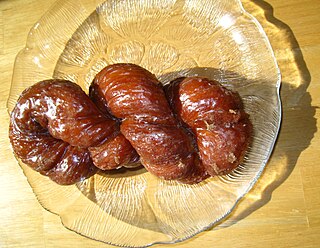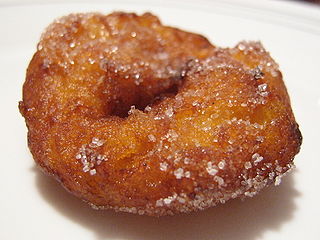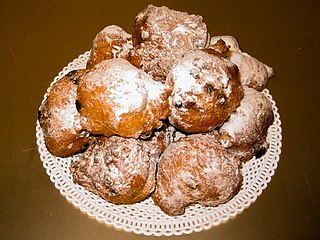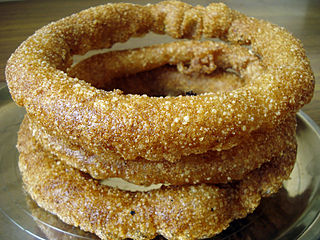
A doughnut or donut is a type of pastry made from leavened fried dough. It is popular in many countries and is prepared in various forms as a sweet snack that can be homemade or purchased in bakeries, supermarkets, food stalls, and franchised specialty vendors. Doughnut is the traditional spelling, while donut is the simplified version; the terms are used interchangeably.

Beignet is a type of deep-fried pastry of French origin. It is commonly made from pâte à choux, but can also be made using rice flour or yeast-leavened batters. Beignets can be served in a variety of preparations, the most common being dusted with confectioner’s sugar. The pastry is popular in French, Italian, and American cuisines.

Zeppola, sometimes called frittelle, and in Sardinia italianized zippole or zeppole sarde from the original Sardinian tzípulas, is an Italian pastry consisting of a deep-fried dough ball of varying size but typically about 4 inches (10 cm) in diameter. This fritter is usually topped with powdered sugar, and may be filled with custard, jelly, cannoli-style pastry cream, or a butter-and-honey mixture. The consistency ranges from light and puffy, to bread- or pasta-like. It is eaten to celebrate Saint Joseph's Day, which is a Catholic feast day.

A cruller is a deep-fried pastry popular in parts of Europe and North America. Regarded as a form of cake doughnut in the latter, it is typically either made of a string of dough that is folded over and twisted twice to create its signature shape, or formed from a rectangle of dough with a cut in the center allowing it to be pulled over and through itself to produce distinctive twists in the sides of the pastry.

Funnel cake is a regional sweet food popular in North America, found mainly at carnivals and amusement parks. It is made by deep-frying batter.

Fried dough is a North American food associated with outdoor food stands in carnivals, amusement parks, fairs, rodeos, and seaside resorts. "Fried dough" is the specific name for a particular variety of fried bread made of a yeast dough; see the accompanying images for an example of use on carnival-booth signs. Fried dough is also known as fry dough, fry bread (bannock), fried bread, doughboys, elephant ears, beaver tails, scones, pizza fritte, frying saucers, and buñuelos. These foods are virtually identical to each other and some yeast dough versions of beignets, and recognizably different from other fried dough foods such as doughnuts or fritters.

A fritter is a portion of meat, seafood, fruit, vegetables, or other ingredients which have been battered or breaded, or just a portion of dough without further ingredients, that is deep-fried. Fritters are prepared in both sweet and savory varieties.

A Krapfen or Berliner is a German jam doughnut with no central hole, made from sweet yeast dough fried in lard or cooking oil, with a jam filling, and usually covered in powdered sugar.

Kreplach are small dumplings in Ashkenazi Jewish cuisine filled with ground meat, mashed potatoes or another filling, usually boiled and served in chicken soup, though they may also be served fried. They are similar to Polish pierogi, Polish and Ukrainian uszka, Russian pelmeni, Italian ravioli or tortellini, German Maultaschen, and Chinese jiaozi and wonton. The dough is traditionally made of flour, water and eggs, kneaded and rolled out thin. Some modern-day cooks use frozen dough sheets or wonton wrappers. Ready-made kreplach are also sold in the kosher freezer section of supermarkets.

Sufganiyah is a round jelly doughnut eaten in Israel and around the world on the Jewish festival of Hanukkah. The doughnut is deep-fried, injected with jam or custard, and then topped with powdered sugar. The doughnut recipe originated in Europe in the 16th century, and by the 19th century was known as a Berliner in Germany. Polish Jews, who called it a ponchik, fried the doughnut in schmaltz rather than lard due to kashrut laws. The ponchik was brought to Israel by Polish Jewish immigrants, where it was renamed the sufganiyah based on the Talmud's description of a "spongy dough".

A buñuelo (Spanish:[buˈɲwelo], alternatively called boñuelo, bimuelo, birmuelo, bermuelo, bumuelo, burmuelo, or bonuelo, is a fried dough fritter found in Spain, Latin America, and other regions with a historical connection to Spaniards, including Southwest Europe, the Balkans, Anatolia, and other parts of Asia and North Africa. Buñuelos are traditionally prepared at Christmas. It will usually have a filling or a topping. In Mexican cuisine, it is often served with a syrup made with piloncillo.

An oliebol is a Dutch beignet, doughnut or fried dough that is traditionally eaten on New Year's Eve. People often eat it with raisins baked inside and with powdered sugar on top. Another variation is made with apple inside instead of raisins. There are similar foods all around the world, for example: Samoan Panikeke. Eaten mostly with a Jam or Butter on top.

Krofne are airy filled doughnuts. They are round and usually filled with jelly, marmalade, jam or chocolate as well as butter, Nutella and cinnamon. They can also be filled with custard, or cream, but that is usually less common. The name comes from German Krapfen, and it is a variation of the Central European pastry known as the Berliner. They are also similar to beignets.

Sel roti is a traditional Nepalese ring-shaped sweet fried dough made from rice flour. It is mostly prepared during Dashain and Tihar, widely celebrated Hindu festivals in Nepal as well as Darjeeling, Kalimpong and Sikkim regions in India. The dish is popular throughout Nepal and among the Indian Gorkha community. Sel roti is made from a batter of rice flour, water, sugar, ghee, and spices which is then deep-fried in cooking oil.

Boortsog or bawïrsaq is a type of fried dough food found in the cuisines of Central Asia, Idel-Ural, Mongolia and the Middle East. It is shaped into either triangles or sometimes spheres. The dough consists of flour, yeast, milk, eggs, butter, salt, sugar, and margarine. Tajik boortsog are often decorated with a criss-cross pattern by pressing the bottom of a small strainer on the dough before it is fried.

A jelly doughnut, or jam donut, is a doughnut with a fruit preserve filling.

A bombolone is an Italian filled doughnut, eaten as a snack food and dessert. The pastry's name is etymologically related to bomba, and the same type of pastry is also called "bomba" in some regions of Italy. The etymological connection is probably due to the resemblance to a grenade or old-fashioned bomb and may today possibly also be regarded as a reference to the high calorie density of this pastry.

The old-fashioned doughnut is a term used for a variety of cake doughnut prepared in the shape of a ring with a cracked surface and tapered edges around it. While many early cookbooks included recipes for "old-fashioned donuts" that were made with yeast, the distinctive cake doughnuts sold in doughnut shops are made with chemical leavener and may have crisper texture compared to other styles of cake doughnuts. The cracked surface is usually glazed or coated with sugar.





















